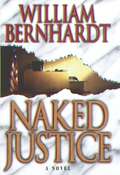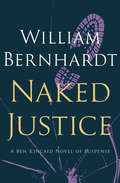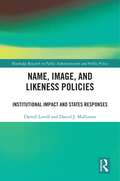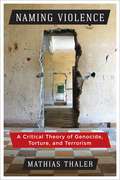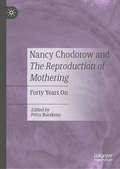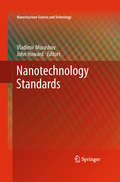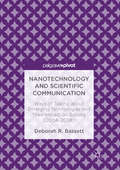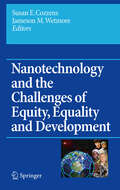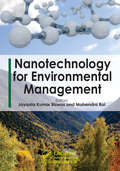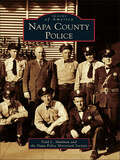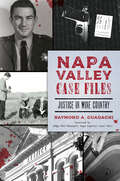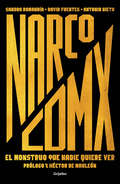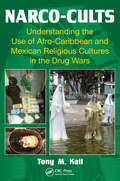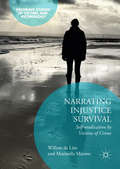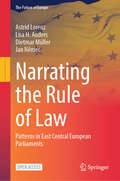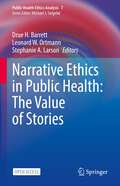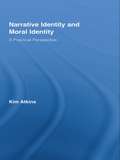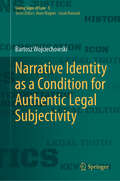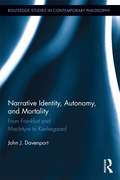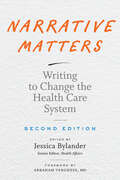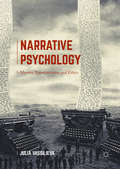- Table View
- List View
Naked Justice (Ben Kincaid Series #6)
by William BernhardtWhen Wallace Barrett is seen fleeing his house, splattered with blood, after his wife and two young daughters are gruesomely murdered, it's going to take one hell of a lawyer to get Barrett off.
Naked Justice (The Ben Kincaid Novels #6)
by William BernhardtA lawyer must defend a mayor accused of murdering his family: &“Bernhardt again proves himself master of the courtroom drama&” (Library Journal). With his winning smile, acting experience, and history as one of the best quarterbacks Oklahoma University has ever seen, Wally Barrett had no trouble becoming Tulsa&’s first black mayor. But this perfect politician has a dark side, too. One afternoon at an ice cream parlor, a dozen people watch as he nearly hits his wife during an argument about their children. That same night, a neighbor calls the police after hearing screams from inside the mayor&’s house. The patrolman discovers the first lady and her children murdered, and the mayor nowhere to be found. Barrett is captured after a high-speed chase, insensible and covered in blood. The only person willing to defend him is Ben Kincaid, a struggling defense lawyer with a history of winning impossible cases. But when the national media descends on Tulsa, Kincaid will have to do something he&’s never done before, and oversee an increasingly wild three-ring circus.
Nakli Waris: नकली वारिस
by Surender Mohan Pathak"नकली वारिस" सुरेंद्र मोहन पाठक द्वारा लिखा गया एक रोमांचक रहस्य उपन्यास है, जिसमें धोखाधड़ी, पहचान की गुत्थी और षड्यंत्र की जटिल कहानी बुनी गई है। कहानी काठमांडू के एक होटल से शुरू होती है, जहां एक अमीर उद्योगपति राजा शिवप्रताप सिंह की कथित बेटी काजल रहस्यमय परिस्थितियों में पाई जाती है। लेकिन जल्द ही, घटनाओं का ऐसा चक्र शुरू होता है, जिससे उसकी असली पहचान पर सवाल उठने लगते हैं। जब डॉक्टर सूर्यदेव थापा को इस मामले की सच्चाई का अहसास होता है, तो उसे जान से मारने की कोशिश की जाती है। पत्रकार सुनील, जो हमेशा सच्चाई की खोज में रहता है, इस गुत्थी को सुलझाने में जुट जाता है। क्या काजल वास्तव में राजा शिवप्रताप सिंह की बेटी है, या उसके नाम पर कोई और वारिस बनने की साजिश कर रहा है? यह उपन्यास पाठकों को रहस्य और सस्पेंस के जाल में बांधकर अंत तक रोमांचित रखता है।
Name, Image, and Likeness Policies: Institutional Impact and States Responses (Routledge Research in Public Administration and Public Policy)
by Darrell Lovell Daniel MallinsonThis book examines the path that name, image, and likeness (NIL) has taken in the first years of the policy, how the expansion has led to differing approaches across state and universities, and how administrators in selected states are dealing with the rulemaking power they have. After an introduction contextualising how NIL policies have impacted the administrative approach at institutions, the remaining chapters focus on how NIL has altered the role of compliance offices and administrators tasked with monitoring academic and financial activity in athletic departments. Chapters leverage theories of policy diffusion and implementation to offer context on the topics from administrative and policy perspectives, whilst also examining how entrepreneurs are both using the policies to advance the status of the athletic arms of their institutions while dealing with these compliance struggles. The authors conclude with a discussion of an unsettled policy landscape and whether stricter guidelines are on the horizon. Name, Image, and Likeness Policies will appeal to both scholars studying sport and law, public policy, public administration, state politics, and governance, as well as readers seeking to better understand what impacts NIL is having on the college system, and students connected to major sports such as college football and basketball.
Naming Violence: A Critical Theory of Genocide, Torture, and Terrorism (New Directions in Critical Theory #52)
by Professor Mathias ThalerMuch is at stake when we choose a word for a form of violence: whether a conflict is labeled civil war or genocide, whether we refer to “enhanced interrogation techniques” or to “torture,” whether a person is called a “terrorist” or a “patriot.” Do these decisions reflect the rigorous application of commonly accepted criteria, or are they determined by power structures and partisanship? How is the language we use for violence entangled with the fight against it?In Naming Violence, Mathias Thaler articulates a novel perspective on the study of violence that demonstrates why the imagination matters for political theory. His analysis of the politics of naming charts a middle ground between moralism and realism, arguing that political theory ought to question whether our existing vocabulary enables us to properly identify, understand, and respond to violence. He explores how narrative art, thought experiments, and historical events can challenge and enlarge our existing ways of thinking about violence. Through storytelling, hypothetical situations, and genealogies, the imagination can help us see when definitions of violence need to be revisited by shedding new light on prevalent norms and uncovering the contingent history of ostensibly self-evident beliefs. Naming Violence demonstrates the importance of political theory to debates about violence across a number of different disciplines from film studies to history.
Nancy Chodorow and The Reproduction of Mothering: Forty Years On
by Petra BueskensThis book analyzes Nancy Chodorow’s canonical book The Reproduction of Mothering, bringing together an original essay from Nancy Chodorow and a host of outstanding international scholars—including Rosemary Balsam, Adrienne Harris, Elizabeth Abel, Madelon Sprengnether, Ilene Philipson, Meg Jay, Daphne de Marneffe, Alison Stone and Petra Bueskens—in a mix of memoir, festschrift, reflection, critical analysis and new directions in Chodorowian scholarship. In the 40 years since its publication, The Reproduction of Mothering has had a profound impact on scholarship across many disciplines including sociology, psychoanalysis, psychology, ethics, literary criticism and women’s and gender studies. Organized as a “reproduction of mothering scholarship”, this volume adopts a generationally differentiated structure weaving personal, political and scholarly essays. This book will be of interest to scholars across the social sciences and humanities. It will bring Nancy Chodorow and her canonical work to a new generation showcasing classic and contemporary Chodorowian scholarship.
Nanotechnology Standards
by John Howard Vladimir MurashovWritten by a team of experts, Nanotechnology Standards provides the first comprehensive, state-of-the-art reviews of nanotechnology standards development, both in the field of standards development and in specific areas of nanotechnology. It also describes global standards-developing processes for nanotechnology, which can be extended to other emerging technologies. For topics related to nanotechnology, the reviews summarize active areas of standards development, supporting knowledge and future directions in easy-to-understand language aimed at a broad technical audience. This unique book is also an excellent resource for up-to-date information on the growing base of knowledge supporting the introduction of nanotechnology standards and applications into the market.
Nanotechnology and Scientific Communication: Ways of Talking about Emerging Technologies and Their Impact on Society (2004-2008)
by Deborah R. BassettThis study examines findings from a 4-year-long ethnography of communication among a research university’s community of scientists and engineers working in nanoscience and nanotechnology. It includes analysis of 20 in-depth interviews with scientists and engineers from 18 different disciplines self-identified as working in nanoscale science and engineering. Using multiple methods of inquiry, including fieldwork, interviews, and textual analysis, elements of a shared speech code are presented, each of which indicate culturally distinctive understandings of psychology, sociology and rhetoric. In particular, the interview data addresses questions such as “What kind of person is a scientist?” “What is the role of science in society?” and “What is the role of communication in science?” This book will appeal to readers interested in science and society, scientific communication, and ethnography of communication.
Nanotechnology and the Challenges of Equity, Equality and Development
by Susan E. Cozzens Jameson WetmoreNanotechnology is enabling applications in materials, microelectronics, health, and agriculture, which are projected to create the next big shift in production, comparable to the industrial revolution. Such major shifts always co-evolve with social relationships. This book focuses on how nanotechnologies might affect equity/equality in global society. Nanotechnologies are likely to open gaps by gender, ethnicity, race, and ability status, as well as between developed and developing countries, unless steps are taken now to create a different outcome. Organizations need to change their practices, and cultural ideas must be broadened if currently disadvantaged groups are to have a more equal position in nano-society rather than a more disadvantaged one. Economic structures are likely to shift in the nano-revolution, requiring policymakers and participatory processes to invent new institutions for social welfare, better suited to the new economic order than those of the past.
Nanotechnology for Environmental Management
by Mahendra Rai Jayanta Kumar Biswas"Nanotechnology for Environmental Management" is your gateway to the latest advancements in environmental science and technology. Edited by leading international scientists, this book delves into the diverse approaches and applications of nanomaterials and nanotechnologies, offering insights into their potential for environmental remediation, energy management, and sustainable development. Each chapter showcases cutting-edge innovations, making this book an essential reference for students, researchers, scientists, technicians, and professionals in environmental management and regulation.Explore the promises and challenges of nanotechnology in addressing environmental issues, and gain valuable perspectives on the future of sustainable development. With its thorough examination of state-of-the-art nanotechnological solutions, "Nanotechnology for Environmental Management" is your indispensable guide to navigating the complexities of environmental science and technology.
Nanotechnology in Modern Animal Biotechnology: Recent Trends and Future Perspectives
by Pawan Kumar Maurya Sanjay SinghThe book introduces the basic concepts of nanotechnology and the various technologies to characterize nanomaterials. It also covers the nanostructural features of mammalian cells/tissues and related nanomechanical properties. In addition, the book comprehensively describes the current state-of-the-art and future perspectives of nanotechnology in biosensors. It also discusses the potential of nanotechnology for delivering the diverse cancer therapeutics and illustrates its limitation due to the potential toxicity associated with oxidative stress. It also highlights the ethical issues and translational aspects related to nanotechnology. Finally, it summarizes the applications of nanotechnology in animal biotechnology, the recent perspectives and future challenges of nanomedicines. The content of the book are beneficial for the undergraduate, postgraduate and doctoral students as well the professionals working in the area of nanotechnology and nanomedicines.
Napa County Police (Images of America)
by Todd L. Shulman Napa Police Historical SocietyThe story of organized law enforcement in Napa County begins with the very first meeting of the board of supervisors in 1850 and the appointment of a county sheriff and marshals for each township. Thefoundations for progress and prosperity in place, Napa County grew from a remote agricultural outpost to the preeminent wine-growing region in the United States and a booming tourist destination�and policinghas kept pace. Today, in addition to the Napa Sheriff�s Department, the county is protected by the California Highway Patrol and three police departments: Napa, St. Helena, and Calistoga. Specialized police agencies have also grown out of unique needs, including the Napa State Hospital Police, Railroad Police, and Community College Police.
Napa Valley Case Files: Justice in Wine Country (True Crime)
by Raymond A. GuadagniWell known for its picturesque setting, Napa Valley is also home to crimes perpetrated in the name of greed, love and rage.Shocking incidents have rocked the small communities nestled among the vineyards, like that of greedy young Billy Duvall, who killed his parents as they slept, and Bob Edwards, who suffocated his beloved wife in a misguided attempt to keep a promise. Two victims of domestic violence came to very different ends--one murdered and the other offered a second chance at life after a jail sentence.Join author and retired Napa Superior Court judge Raymond A. Guadagni as he offers his unique perspective on these notorious court cases and the criminal justice system.
Narco CDMX: El monstruo que nadie quiere ver
by David Fuentes Sandra Romandia Antonio NietoEl narco inunda el país... excepto la Ciudad de México. Por increíble que parezca, ése ha sido el discurso oficial de todos los gobernantes que ha tenido la capital del país. Ningún jefe de gobierno, nunca, ha aceptado que los cárteles campean en el corazón de México. Este libro los refuta y evidencia el problema. Caso a caso, documenta qué grupos se pelean las 16 alcaldías, cómo operan, qué está en juego y de qué tamaño es el monstruo que las autoridades se niegan a ver. Aquí está todo. Así, Narco CDMX demuestra que, en el ajedrez del crimen organizado, la Ciudad de México juega un rol muchísimo más importante de lo que se pensaba. Y alerta: seguir ignorando el desastre pone en riesgo la viabilidad de toda la nación. Es la última llamada. Prólogo de Héctor de Mauleón
Narco-Cults: Understanding the Use of Afro-Caribbean and Mexican Religious Cultures in the Drug Wars
by Tony M. KailThose who know about how spirituality plays into the world of drug smuggling have likely heard of Santa Muerte, Jesus Malverde, and Santer but the details of the more obscure African religions and Latin American folk saints and cults often remain a mystery. While the vast majority of these religions are practiced by law-abiding citizens with no co
Narcocapitalismo: Para acabar con la sociedad de la anestesia
by Laurent de SutterDescubre al enfant terrible de la filosofía francófona. Cómo romper con las emociones inducidas y recuperar los sentimientos reales. Antidepresivos, somníferos, cocaína, analgésicos. Nuestras vidas parecen farmacias. Ya no podemos funcionar sin la ayuda de sustancias químicas: una pastilla para despertar, otra para trabajar, la siguiente para salir de fiesta, otra para evitar la resaca y la última para dormir. Vivimos en la era de la anestesia, somos una sociedad narcotizada al gusto del capital: un cuerpo social apático, reclutado y dopado para mantener el ritmo de producción alto y el orden establecido intacto. ¿Qué tienen en común la invención de la anestesia a mediados del siglo XIX, el empleo que dieron los nazis a la cocaína y el desarrollo del Prozac? Son productos con una misma lógica: el control de las emociones y el abandono de la excitación. Hemos olvidado lo que es el entusiasmo porquela única excitación que conocemos está inducida por los fármacos. Este provocador ensayo indaga en la historia, el psicoanálisis, la filosofía y la economía para llamarnos a abandonar la estimulación narcótica y encontrar el camino de vuelta a la excitación política y colectiva: ese es el mayor miedo del narcocapitalismo. La crítica ha dicho...«Una de las figuras más destacadas del mundo intelectual contemporáneo.»Actualitté «De Sutter nos invita a rechazar el adormecimiento de los sentidos.»Livres Hebdo «Un gran libro, poderoso y original, que nos hace pensar más allá de lo que parece abordar.»Diacritik «Un libro fascinante que se puede leer de varias maneras: como una breve historia de la psicofarmacología moderna, como una teoría política contemporánea basada en la anestesia del cuerpo social, o como una demolición filosófica de la dimensión ontológica de la depresión. Debería ser lectura obligatoria para cualquier filósofo, psicoanalista o activista social interesado en conocer la excitación que produce una aventura intelectual auténtica.»Franco “Bifo” Berardi, autor de La máquina de la infelicidad y Fenomenología del fin
Narrating Injustice Survival: Self-medication by Victims of Crime (Palgrave Studies in Victims and Victimology)
by Willem De Lint Marinella MarmoThis book explores the role of self-medication in reflexive response to victimhood and victim recovery. Based on interviews, counsellor focus groups and a self-medication survey, it situates self-medication among the coping strategies that may be set in formal and informal networks. Victims primarily seek validation, and this book reviews self-medication with particular focus on how victim-survivors develop a variety of reflexive responses in their attempt to carve out a dignified response to victimization. Validation may be achieved through the pursuit of justice, but many victims suffer from multiple or complex victimisation, with limited social chances necessary to achieve a just outcome. Routines, beliefs and an ordered pathway distinguish a dignified identity and more or less successful recovery adaptations. This book also addresses the practical implications of the findings for support organisations.
Narrating the Rule of Law: Patterns in East Central European Parliaments (The Future of Europe)
by Astrid Lorenz Dietmar Müller Lisa H. Anders Jan NěmecThis open access book deals with the backsliding of the rule of law in Poland and Hungary as one of the main problems of the EU. What began as a national phenomenon has become a general threat for the EU because the respect for the rule of law is a prerequisite for all other values of the EU enshrined in Article 2 of the Treaty on European Union. Media coverage and scholarly publications on these developments mainly focus on backsliding governments and judicial decisions concerning the issue. This book aims to inform the debate by adding another perspective and providing a broader view. Drawing on a comprehensive collection of parliamentary debates, we explore how MPs in Poland, Hungary, but also the Czech Republic, Slovakia and Romania referred to the rule of law from 1990 to 2021 and how their narratives differed across parties, countries and time.
Narrative Ethics in Public Health: The Value of Stories (Public Health Ethics Analysis #7)
by Drue H. Barrett Leonard W. Ortmann Stephanie A. LarsonThis Open Access book illustrates the power of stories to illuminate ethical concerns that arise in public health. It complements epidemiological or surveillance evidence, and reveals stakeholder perspectives crucial for public health practitioners to develop effective and ethical public health interventions. Because it relies on the natural and universal appeal of stories, the book also serves to introduce the field of public health to students considering a career in public health. The opening section of the book also serves as a more didactic introduction to public health ethics and the field of narrative ethics. It describes the field of public health ethics including ethical principles relevant to public health practice and research, and the advantages of a narrative ethics approach. That approach explores the problems and the ethical challenges of public health from the inside, from the perspective of those experiencing health problems to the challenges of those who must address these problems. The later sections consist of 14 chapters that present the actual stories of these public health problems and challenges. In narrative style they range from first person narratives of both practitioners and citizens, to analysis of published short stories. The problems and challenges they address include issues relating to justice concerns, surveillance and stigma, community values and the value of community, trust and the value of information, and freedom and responsibility. Specific public health topics include resource allocation, restricting liberty to protect the community from health threats, and the health impact of trauma, addiction, obesity and health disparities.
Narrative Hospitality in Late Victorian Fiction: Novel Ethics (Routledge Studies in Nineteenth Century Literature)
by Rachel HollanderBringing together poststructuralist ethical theory with late Victorian debates about the morality of literature, this book reconsiders the ways in which novels engender an ethical orientation or response in their readers, explaining how the intersections of nation, family, and form in the late realist English novel produce a new ethics of hospitality. Hollander reads texts that both portray and enact a unique ethical orientation of welcoming the other, a narrative hospitality that combines the Victorians’ commitment to engaging with the real world with a more modern awareness of difference and the limits of knowledge. While classic nineteenth-century realism rests on a sympathy-based model of moral relations, novels by authors such as George Eliot, Thomas Hardy, and Olive Schreiner present instead an ethical recognition of the distance between self and other. Opening themselves to the other in their very structure and narrative form, the visited texts both represent and theorize the ethics of hospitality, anticipating twentieth-century philosophy’s recognition of the limits of sympathy. As colonial conflicts, nationalist anxiety, and the intensification of the "woman question" became dominant cultural concerns in the 1870s and 80s, the problem of self and other, known and unknown, began to saturate and define the representation of home in the English novel. This book argues that in the wake of an erosion of confidence in the ability to understand that which is unlike the self, a moral code founded on sympathy gave way to an ethics of hospitality, in which the concept of home shifts to acknowledge the permeability and vulnerability of not only domestic but also national spaces. Concluding with Virginia Woolf’s reexamination of the novel’s potential to educate the reader in negotiating relations of alterity in a more fully modernist moment, Hollanders suggest that the late Victorian novel embodies a unique and previously unrecognized ethical mode between Victorian realism and a post-World- War-I ethics of modernist form.
Narrative Identity and Moral Identity: A Practical Perspective (Routledge Studies in Contemporary Philosophy #Vol. 14)
by Kim AtkinsThis book is part of the growing field of practical approaches to philosophical questions relating to identity, agency and ethics--approaches which work across continental and analytical traditions and which Atkins justifies through an explication of how the structures of human embodiment necessitate a narrative model of selfhood, understanding, and ethics.
Narrative Identity as a Condition for Authentic Legal Subjectivity (Living Signs of Law #5)
by Bartosz WojciechowskiThis book argues that omitting the component of narrative creates an irresolvable antinomy concerning the identity of the subject: between the subject and identical copies of itself in different situations, or between it and the identical subject as a substantial illusion, the elimination of which reveals the pure multitude of desires, emotions, and perceptions. The starting point of the considerations presented here is the conviction that knowledge of one’s own desires and preferred values is obtained by articulating a narrative identity through social interactions and mutually determined moral horizons that presuppose shared meanings and the possibility of consensus. The book emphasizes the significance of personal narration and identity formation, but also points out that collective narrative, which is culturally and traditionally rooted, is also one’s own narrative. It focuses on the issue of identity, which is discussed today in numerous contexts, and the understanding of which, according to the author, has important consequences, including: for the legal aspects of our lives, as it concerns, for example, the rights of LGBTQ+ people or entities marginalized or excluded for various reasons. The titular narrative identity of an authentic legal entity is related to opening ourselves to others, but also to ourselves. The interdisciplinary research perspective adopted in the book combines literary aspects, philosophical, sociological and theoretical-legal considerations with an analysis of the jurisprudence of European tribunals.
Narrative Identity, Autonomy, and Mortality: From Frankfurt and MacIntyre to Kierkegaard (Routledge Studies in Contemporary Philosophy)
by John J. DavenportIn the last two decades, interest in narrative conceptions of identity has grown exponentially, though there is little agreement about what a "life-narrative" might be. In connecting Kierkegaard with virtue ethics, several scholars have recently argued that narrative models of selves and MacIntyre's concept of the unity of a life help make sense of Kierkegaard's existential stages and, in particular, explain the transition from "aesthetic" to "ethical" modes of life. But others have recently raised difficult questions both for these readings of Kierkegaard and for narrative accounts of identity that draw on the work of MacIntyre in general. While some of these objections concern a strong kind of unity or "wholeheartedness" among an agent's long-term goals or cares, the fundamental objection raised by critics is that personal identity cannot be a narrative, since stories are artifacts made by persons. In this book, Davenport defends the narrative approach to practical identity and autonomy in general, and to Kierkegaard's stages in particular.
Narrative Matters: Writing to Change the Health Care System
by Jessica BylanderDrawn from the popular "Narrative Matters" column in the journal Health Affairs, these essays embody a vision for a health care system that centers the humanity of patients and doctors alike.Health care decision making affects patients and families first and foremost, yet their perspectives are not always factored into health policy deliberations and discussions. In this anthology, Jessica Bylander brings together the personal stories of the patients, physicians, caregivers, policy makers, and others whose writings add much-needed human context to health care decision making.Drawn from the popular "Narrative Matters" column in the leading health policy journal Health Affairs, this collection features essays by some of the leading minds in health care today, including Pulitzer Prize–winner Siddhartha Mukherjee, MacArthur fellow Diane Meier, former Planned Parenthood president Leana S. Wen, and former secretary of health and human services Louis W. Sullivan. The collection also presents important stories from lesser-known voices, including a transgender doctor in Oklahoma who calls for better treatment of trans patients and a palliative care physician who reflects on how perspectives on hastening death have changed in recent years. A foreword written by National Humanities Medal recipient Abraham Verghese, MD, further rounds out the book.The collection of thirty-two essays is organized around several themes:• the practice of medicine • medical innovation and research• patient-centered care• the doctor-patient relationship• disparities and discrimination• aging and end-of-life care• maternity and childbirth• opioids and substance abuseContributors: Louise Aronson, Laura Arrowsmith, Cheryl Bettigole, Cindy Brach, Gary Epstein-Lubow, Jonathan Friedlaender, Patricia Gabow, Katti Gray, Yasmin Sokkar Harker, Timothy Hoff, Carla Keirns, Raya Elfadel Kheirbek, Katy B. Kozhimannil, Pooja Lagisetty, Maria Maldonado, Maureen A. Mavrinac, Diane E. Meier, Dina Keller Moss, Siddhartha Mukherjee, Donna Jackson Nakazawa, Travis N. Rieder, Aroonsiri Sangarlangkarn, Elaine Schattner, Janice Lynch Schuster, Myrick C. Shinall, Gayathri Subramanian, Louis W. Sullivan, Gautham K. Suresh, Abraham Verghese, Otis Warren, Leana S. Wen, Charlotte Yeh
Narrative Psychology
by Julia VassilievaThis book provides the first comparative analysis of thethree major streams of contemporary narrative psychology as they have beendeveloped in North America, Europe, and Australia and New Zealand. Interrogating the historical and cultural conditions in which this importantmovement in psychology has emerged, the book presents clear, well-structuredcomparisons and critique of the key theories of narrative psychology pioneeredacross the globe. Examples include Dan McAdams in the US and his followers, whohave developed a distinctive approach to self and identity as a life story overthe past two decades; in the Netherlands by Hubert Hermans, whose research onthe 'dialogical self' has made the University of Nijmegen a centre of narrativepsychological research in Europe; and in Australia and New Zealand, where thecollaborative efforts of Michael White and David Epston helped to launch thenarrative movement in psychotherapy in the late 1980s.
